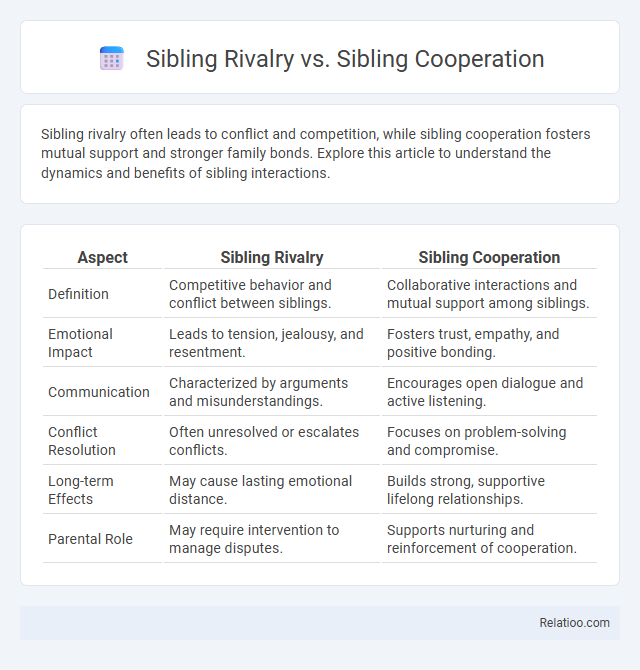Sibling rivalry often leads to conflict and competition, while sibling cooperation fosters mutual support and stronger family bonds. Explore this article to understand the dynamics and benefits of sibling interactions.
Table of Comparison
| Aspect | Sibling Rivalry | Sibling Cooperation |
|---|---|---|
| Definition | Competitive behavior and conflict between siblings. | Collaborative interactions and mutual support among siblings. |
| Emotional Impact | Leads to tension, jealousy, and resentment. | Fosters trust, empathy, and positive bonding. |
| Communication | Characterized by arguments and misunderstandings. | Encourages open dialogue and active listening. |
| Conflict Resolution | Often unresolved or escalates conflicts. | Focuses on problem-solving and compromise. |
| Long-term Effects | May cause lasting emotional distance. | Builds strong, supportive lifelong relationships. |
| Parental Role | May require intervention to manage disputes. | Supports nurturing and reinforcement of cooperation. |
Understanding Sibling Dynamics
Understanding sibling dynamics involves analyzing patterns of interaction shaped by rivalry and cooperation within the family unit. Sibling rivalry often emerges from competition for parental attention and resources, influencing emotional development and conflict resolution skills. In contrast, sibling cooperation fosters collaboration and support, contributing to social competence and lifelong relationship building.
Defining Sibling Rivalry
Sibling rivalry is characterized by competition, jealousy, and conflict between brothers and sisters, often stemming from struggles for parental attention or perceived favoritism. Unlike sibling cooperation, which involves mutual support, collaboration, and positive interaction, rivalry generates tension that can affect family dynamics and emotional well-being. Understanding the defining traits of sibling rivalry is crucial for managing conflicts and fostering healthier relationships within the sibling bond.
Exploring Sibling Cooperation
Sibling cooperation fosters positive relationships by encouraging teamwork, empathy, and mutual support, which contrast sharply with the conflict often seen in sibling rivalry. Your family dynamics improve significantly when siblings collaborate rather than compete, promoting emotional resilience and effective communication skills. Exploring sibling cooperation offers valuable insights into building harmonious interactions that benefit long-term familial bonds.
Causes of Sibling Rivalry
Sibling rivalry often stems from competing for parental attention, differences in age or personality, and perceived favoritism, creating tension within family dynamics. Sibling cooperation emerges when mutual respect, shared goals, and effective communication replace rivalry, fostering positive relationships. Understanding the underlying causes of sibling rivalry helps you develop strategies to promote harmony and strengthen sibling bonds.
Factors Promoting Sibling Cooperation
Factors promoting sibling cooperation include shared positive experiences, effective communication, and mutual respect, which contribute to harmonious interactions and reduced conflict. Parental modeling of cooperative behavior and structured family activities also enhance sibling bonds by fostering teamwork and empathy. These elements create a supportive environment where siblings are more likely to collaborate rather than compete.
Psychological Effects of Rivalry
Sibling rivalry often leads to increased stress, anxiety, and feelings of inadequacy in children, negatively impacting their emotional development and self-esteem. In contrast, sibling cooperation fosters social skills, empathy, and conflict resolution abilities, creating a supportive family environment that promotes psychological well-being. Understanding these dynamics helps you nurture healthier relationships and mitigate the harmful effects rivalry can have on your children's mental health.
Emotional Benefits of Cooperation
Sibling cooperation fosters emotional benefits such as increased empathy, stronger trust, and enhanced conflict resolution skills. Your ability to navigate sibling dynamics through cooperation promotes a supportive family environment that reduces rivalry-induced stress. Positive interactions between siblings contribute significantly to emotional resilience and overall mental well-being.
Parental Influence on Sibling Relationships
Parental influence significantly shapes sibling rivalry and cooperation by modeling conflict resolution and fostering empathy in sibling dynamics. You can encourage positive interactions by setting clear family rules and promoting shared activities that build teamwork and mutual respect. Healthy parental guidance reduces rivalry intensity, enhancing emotional bonds and cooperation among siblings.
Strategies to Reduce Rivalry and Foster Cooperation
Sibling rivalry often stems from competition for parental attention, but implementing clear communication, establishing fair rules, and encouraging shared goals can effectively reduce conflicts. You can foster sibling cooperation by promoting collaborative problem-solving, reinforcing positive interactions, and recognizing individual achievements to build mutual respect. Understanding the dynamics of sibling relationships helps tailor strategies that transform rivalry into supportive bonds, enhancing overall family harmony.
Lifelong Impact of Sibling Interaction
Sibling rivalry, sibling cooperation, and overall sibling dynamics significantly shape your emotional development and social skills throughout life. Rivalrous interactions may lead to heightened stress and conflict resolution challenges, while cooperative behaviors foster empathy, teamwork, and stronger family bonds. Understanding and nurturing positive sibling dynamics can contribute to better mental health and lifelong interpersonal success.

Infographic: Sibling Rivalry vs Sibling Cooperation
 relatioo.com
relatioo.com